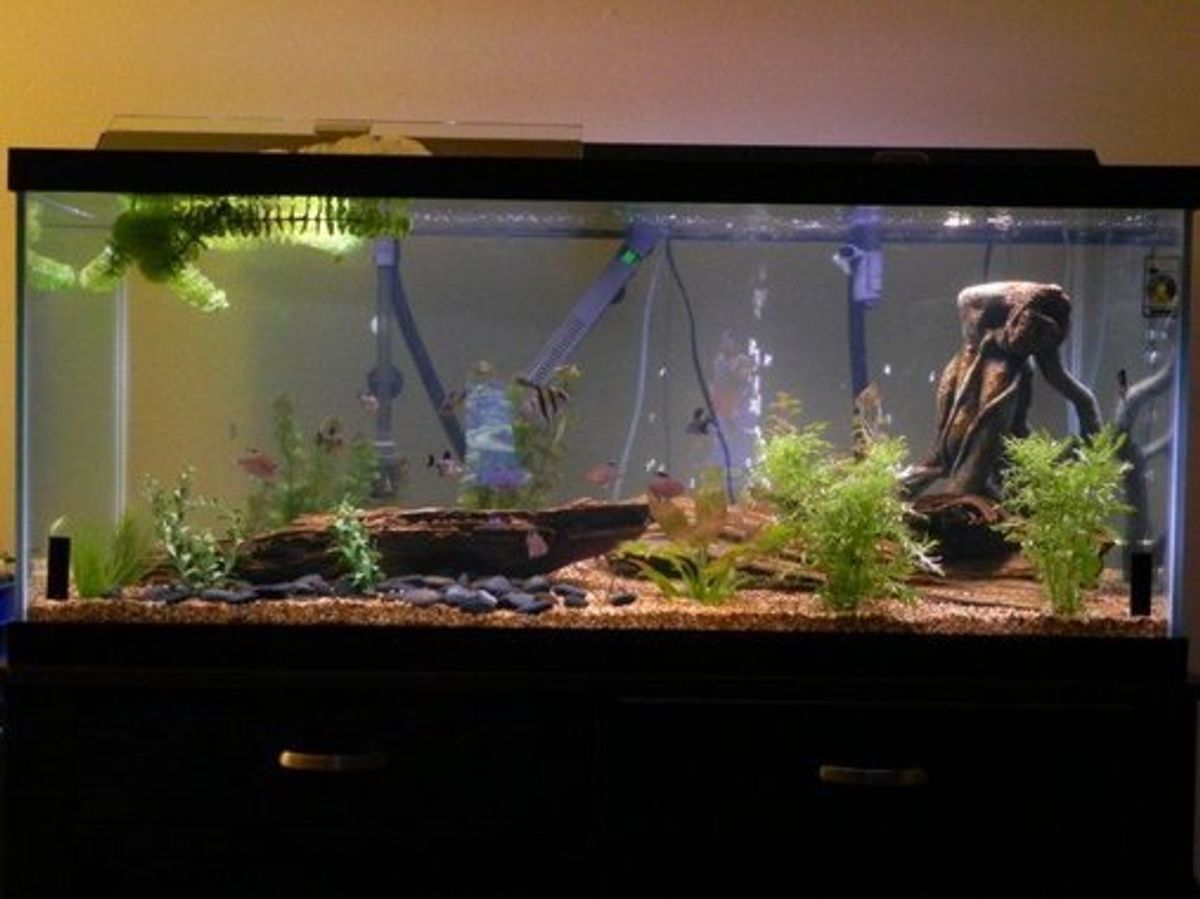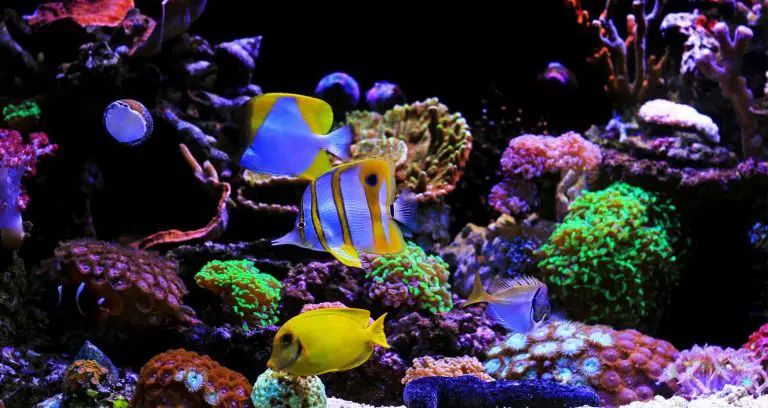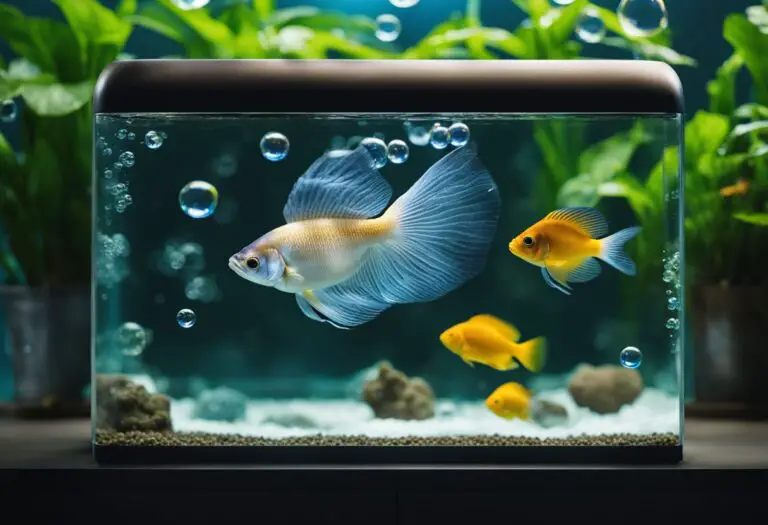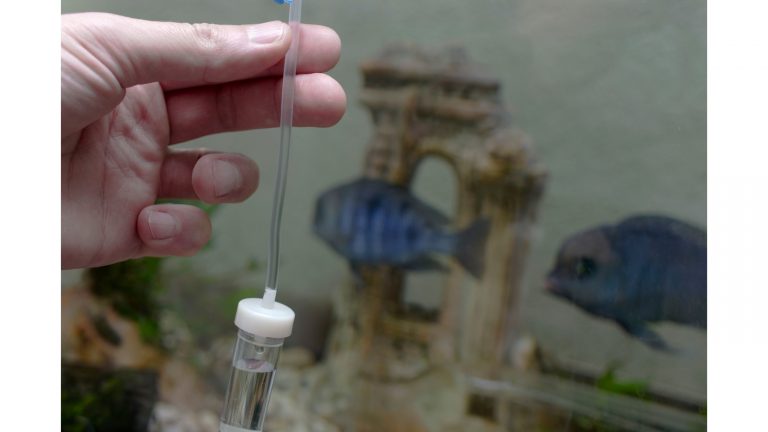13 Importance of Fish Tank Cycling: What Does Cycling a Fish Tank Mean?
When you “cycle” a fish tank, you are essentially establishing the nitrogen cycle in your aquarium.
The nitrogen cycle is the process by which ammonia (a toxic waste product) is converted into nitrites (also toxic), and then finally into nitrates (relatively harmless).
This process is completed by bacteria that live in your aquarium filter media and on other surfaces in your tank.
Cycling a fish tank means introducing bacteria to the water that will help to break down ammonia.
Ammonia is produced by fish waste and can be harmful to fish in high levels. The bacteria will convert the ammonia into nitrites, which are also harmful to fish.
However, there is another type of bacteria that will convert the nitrites into nitrates, which are not as harmful to fish.
The process of cycling a fish tank can take several weeks, but it is important to do it before adding any fish.
You will need to test the water regularly to make sure that the levels of ammonia and nitrites are staying low.
Once the levels of nitrates start rising, you can add a few fish to the tank. It is important to remember that even after cycling a fish tank, you will still need to do regular water changes to keep the water quality high and prevent ammonia and nitrite levels from spikes.
How to Cycle a Tank in 24 Hours ?
“How to Cycle a Tank in 24 Hours If you’re new to the aquarium hobby, you may be wondering what “cycling” a tank means.
Cycling a tank is the process of establishing beneficial bacteria colonies in your aquarium that will help to break down ammonia and nitrites.
Ammonia and nitrites are harmful to fish, so it’s important to get rid of them before adding fish to your tank.
The good news is that cycling a tank doesn’t have to take weeks or even months like it used to. With some careful planning, you can cycle a tank in as little as 24 hours!
Here’s how:
Choose your filter wisely. The type of filter you use will play a big role in how quickly your tank cycles.
Canister filters and hang-on-back filters are both great choices for fast cycling. Avoid using undergravel filters, as they tend to cycle more slowly.
Add ammonia sources. To jumpstart the bacterial growth process, you’ll need to add ammonia sources to your tank.
You can use pure ammonia (available at hardware stores), or you can add fish food or shrimp pellets if you prefer notto use chemicals.
Be sure not to overdo it too much ammonia will stress out your future fish! Aim for an ammonia level between 2-4ppm (parts per million).
Test the levels with an accurate test kit daily until they stabilise around this range this usually takes 3-5 days.
Introduce bacteria starters. In additionto adding ammonia sources, you’ll also need to introduce bacteria starters into your tank.
Bacteria starters are live cultures of beneficial bacteria that help speed up the cycling process by immediately introducing large numbers of good bacteria into your system.
You can find them at most pet stores just be sure to get ones that are specifically labelled for aquariums, as some products contain dangerous strains of bacteria intended for other purposes such as soil enrichment.
Once introduced, keep an eye on the water quality closely for any changes and perform regular water changes according to the instructions on the product packaging until the nitrogen cycle is complete (usually 7-10 days).
Monitor water quality closely. It’s important to monitor water quality closely during the entire cycling process, as sudden spikes in ammonia or nitrite levels can be deadly to fish.
How Often Should You Do Water Changes When Cycling a Tank?
If you are cycling a tank, it is important to do regular water changes. The frequency of water changes will depend on the size of your tank and the fish that you have in it. For a small tank (10 gallons or less), you should do a water change every week.
For a medium-sized tank (20 to 40 gallons), you should do a water change every two weeks. For a large tank (60 gallons or more), you should do a water change every month. The reason for doing regular water changes is to remove the ammonia and nitrites that build up in the water.
Ammonia and nitrites are poisonous to fish, so it is important to keep them at low levels. Water changes also help to keep the tank clean and free of algae.
Signs of a Cycled Aquarium
Aquarium cycling is the process of establishing beneficial bacteria in your tank that will help break down waste products.
There are a few different ways to cycle an aquarium, but the most common and recommended method is to use live plants.
One of the first signs that your aquarium is successfully cycling is when you see nitrites begin to appear in your water tests.
Nitrites are a byproduct of the nitrification process and are harmless to fish in small concentrations.
As your tank cycles, you will also see ammonia levels spike and then drop as nitrites increase. Eventually, both ammonia and nitrite levels should stabilize at 0 ppm.
Another sign that your aquarium has cycled is the growth of algae. Algae blooms are common during the early stages of cycling as beneficial bacteria begin to establish themselves in the system.
These blooms should eventually subside on their own as the bacteria population grows and balances out.
If you notice any of these signs in your aquarium, it’s a good indication that your tank is successfully cycling!
How Long Should I Cycle My Tank before Adding Fish?
If you’re thinking about adding fish to your aquarium, you might be wondering how long you need to cycle your tank before they can safely move in.
The good news is that with a little bit of planning, you can get your new fishies settled into their new home in no time at all.
The first thing you’ll need to do is set up your aquarium and make sure it’s properly cycled.
This process usually takes around 4-6 weeks, during which time harmful ammonia and nitrites will build up in the water.
Once these levels have stabilized, your tank is ready for fish. When choosing your fish, it’s important to remember that not all species can tolerate high levels of ammonia and nitrites.
So, it’s best to avoid adding any sensitive fish until after your tank has been cycled for at least 8 weeks.
This will give the beneficial bacteria in your filter plenty of time to break down these toxins.
Once your tank is ready and you’ve chosen some hardy fish, it’s time to start acclimating them to their new home.
The best way to do this is by slowly mixing some of the water from their transport bag with the water in the aquarium over a period of about an hour.
This will help them adjust to the temperature and chemistry of their new environment without shocking them too much.
After an hour or so, you can release your fish into their new home and sit back enjoy watching them swim around!
Just remember to keep an eye on them for the first few days/weeks as they settle in and acclimate to their new surroundings.
How to Cycle a Fish Tank in a Week?
If you’ve ever wondered how to cycle a fish tank in a week, here’s your complete guide!
Cycling a fish tank simply means allowing time for the beneficial bacteria to grow and establish themselves in the system so that they can break down ammonia produced by the fish.
This process is essential for keeping your fish healthy and preventing harmful ammonia spikes.
There are two main ways to cycle a fish tank: with fish or without fish. We’ll cover both methods so that you can decide which is best for you and your aquarium setup.
To cycle a fish tank with fish, also known as the “fish-in” method, start by adding a few hardy species of fish that can tolerate high levels of ammonia.
Check with your local pet store or aquarium expert to find out which species are best suited for this purpose. Over the course of several weeks, these hardy little guys will produce ammonia, which will be broken down by the beneficial bacteria as they establish themselves in the system. You’ll need to do regular water tests during this time to ensure that ammonia levels remain stable and don’t spike too high, which could harm or even kill your fish.
Once ammonia levels have remained stable for at least two weeks, you can slowly start adding more sensitive species of fish to your tank. Alternatively, if you’d prefer not to add any fish during the cycling process, you can use pure ammonium chloride solution (often sold as “aquarium salt”) to simulate fish waste. Simply add the recommended amount of salt according to package directions.
Ammonia produced by decomposing plant matter will also contribute to cycling the aquarium, so live plants are recommended but not required. As with the “fish-in” method, water testing is essential during this process. The bacteria needed to break down ammonia will take longer to establish themselves without actual fish producing it, so expect this method to take 4-6 weeks before being able to add sensitive species of fish.
Cycling an aquarium doesn’t have to be complicated or scary. With a little patience and regular water testing, you’ll be ready to welcome new additions to your underwater world in no time!
How to Skip Cycling a Tank?
When starting a new aquarium, it is often recommended to “cycle” the tank before adding fish. This process can take several weeks and involves adding ammonia to the water to create an environment that is conducive to the growth of nitrifying bacteria. However, there are ways to bypass this process and add fish to your tank immediately.
One way to do this is by using live plants. Plants absorb ammonia and other toxins from the water, making the water safer for fish. Many beginner aquarists choose this method as it eliminates the need to cycle their tank and wait for nitrifying bacteria to grow.
Another way to skip cycling your tank is by using filter media from an established aquarium. This media will already contain nitrifying bacteria that will help keep your new aquarium safe for fish. You can also purchase bottled bacteria that can be added directly to your new aquarium.
This method is often used by experienced aquarists who are setting up multiple tanks at once and don’t have time to wait for each one to cycle separately.
Regardless of which method you choose, it is important to monitor your water quality closely when adding fish to a new aquarium. Regular water changes and careful feeding will help ensure that your fish stay healthy in their new home!
How to Cycle a Fish Tank Quickly?
If you’re looking to cycle a fish tank quickly, there are a few things you can do to speed up the process. First, if you have an existing aquarium with healthy bacteria, you can use some of the water from that tank to jumpstart the new one. This will help to seed the new tank with bacteria that will begin breaking down ammonia and nitrites.
Another way to cycle a fish tank quickly is by using live plants. Plants help to absorb ammonia and nitrites, which helps to keep levels low in the tank. You can also add a product like Dr. Tim’s One & Only Nitrifying Bacteria to your filter media or directly into the water.
This product contains live bacteria that will help to establish the nitrogen cycle in your new aquarium.
Finally, be sure to provide plenty of aeration in your tank during the cycling process. Aeration helps dissolved oxygen levels remain high, which is necessary for both fish and beneficial bacteria alike.
Fish in Cycle
Fish in Cycle is an innovative new program that allows fish to be recycled into a usable form of fertilizer. The process begins with the capture of fish waste, which is then transported to a facility where it is converted into a liquid form. This liquid is then applied to crops, where it provides nutrients that help the plants grow.
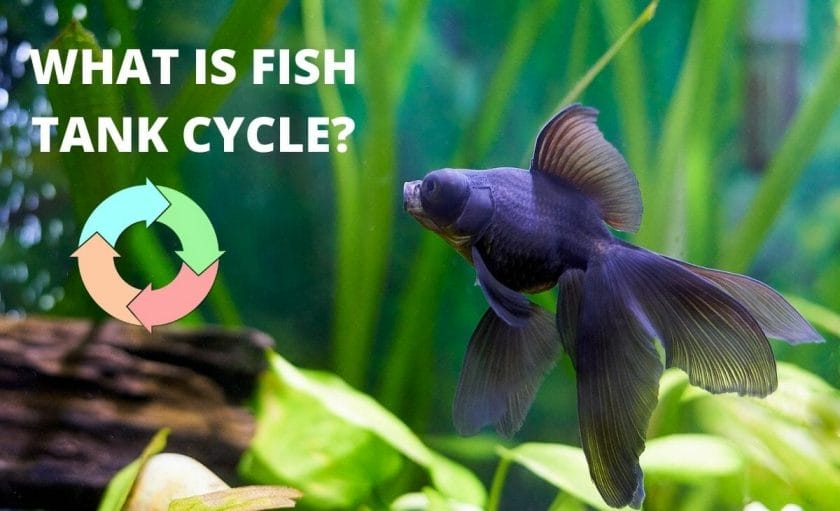
Credit: aquagoodness.com
How Do You Cycle a Fish Tank?
If you’ve never done it before, cycling a fish tank can seem like a daunting task. But don’t worry, we’ll walk you through the process step-by-step so that you can get your new aquarium up and running in no time!
The first thing you need to do is set up your tank.
This includes adding all of the necessary equipment, such as a filter, heater, and air pump. Once your tank is set up, it’s time to add some water. You’ll want to use dechlorinated water so that your fish aren’t exposed to harmful chemicals.
Once your tank has water in it, it’s time to add some fish! We recommend starting with just a few fish so that they don’t put too much stress on the new ecosystem you’re creating. Over the next few weeks, you’ll need to keep an eye on your ammonia and nitrite levels using a test kit.
Ammonia and nitrites are poisonous to fish, so it’s important to make sure that they remain at safe levels while the beneficial bacteria in your filter are growing.
You may also notice some algae growth during this time. While unsightly, it’s actually a good sign that things are progressing as they should!
The algae are feeding off of the same ammonia and nitrites that would be harmful to your fish, which means that they’re helping to keep those levels down.
After about 6-8 weeks, you should have a fully cycled tank!
How Long Does It Take to Cycle a Fish Tank?
It takes anywhere from two to six weeks to cycle a fish tank. The time it takes to cycle a tank depends on a number of factors, including the size of the tank, the type of fish you are keeping, and the amount of filtration you have in place. In general, it is best to err on the side of caution and give your tank plenty of time to cycle before adding any fish.
Is It Necessary to Cycle a Fish Tank?
When starting a new fish tank, it is necessary to cycle the tank before adding any fish. The cycling process establishes beneficial bacteria in the tank that will break down ammonia and nitrites produced by the fish. Ammonia and nitrites are toxic to fish, so it is important to have these levels as low as possible.
The beneficial bacteria that are established during the cycling process help to keep these levels low.
The cycling process can take anywhere from 4-8 weeks. During this time, you will need to test the water regularly to make sure that ammonia and nitrite levels are staying low.
Once they have remained low for at least 2 weeks, you can then add a few fish to the tank. You will still need to continue testing the water during this time period and add more fish slowly over a period of several weeks until your tank is fully stocked.
While it takes some patience, cycling your fish tank is essential for ensuring the health of your fish long-term.
How Do You Know When Your Fish Tank is Cycled?
One of the most important things to know as a fish keeper is how to cycle your aquarium. Cycling your aquarium is the process of establishing beneficial bacteria in your tank that will break down ammonia and nitrites. Ammonia and nitrites are waste products produced by fish that can be toxic to them at high levels.
The good news is that there are bacteria that will consume these waste products and convert them into less harmful compounds. The first step in cycling your aquarium is to test the water for ammonia, nitrites, and nitrates. You can purchase a water testing kit at your local pet store or online.
Test the water before you add any fish to your tank. Ammonia should be at 0 ppm (parts per million), nitrites should be at 0 ppm, and nitrates should be below 20 ppm. If ammonia or nitrites are present, do not add any fish to your tank until they have reached 0 ppm.
Once you have added fish to your tank, you will need to test the water weekly for ammonia, nitrites, and nitrates. It typically takes 4-6 weeks for a new tank to become fully cycled. During this time period, it is important to do partial water changes regularly (about every other day) to keep ammonia and nitrite levels low enough that they won’t harm your fish.
You can begin doing larger (20-30%) partial water changes once the levels of ammonia and nitrite start consistently staying at 0 ppm between tests. It’s important not to add too many fish during the cycling process because more fish means more waste, which can lead to higher levels of ammonia and nitrite.
When adding new fish during this time period, do so gradually (a few at a time every week or two) so that the beneficial bacteria can keep up with the extra waste production.
You will know that your tank has finished cycling when you no longer see any rise in ammonia or nitrite levels over several weeks despite not changing any of the water. Nitrate levels may still increase during this time, but as long as ammonia and nitrite remain undetectable, congratulations! You’ve successfully cycled your aquarium!
HOW TO CYCLE AN AQUARIUM TANK TALK Presented by KGTropicals?
Conclusion
Cycling a fish tank means adding ammonia to the water in order to create nitrites, which are then converted into nitrates. This process is necessary in order to provide a healthy environment for your fish.
